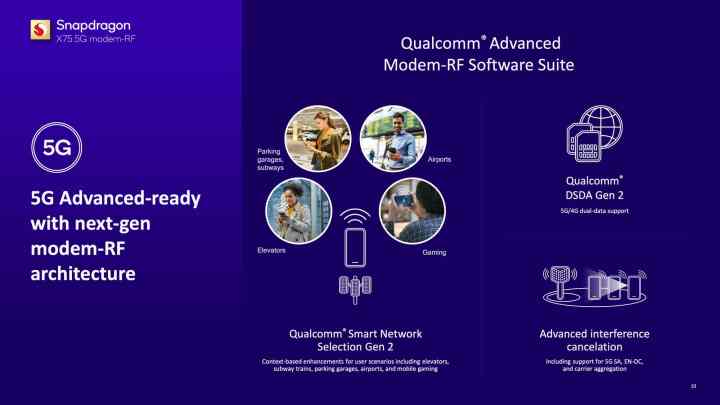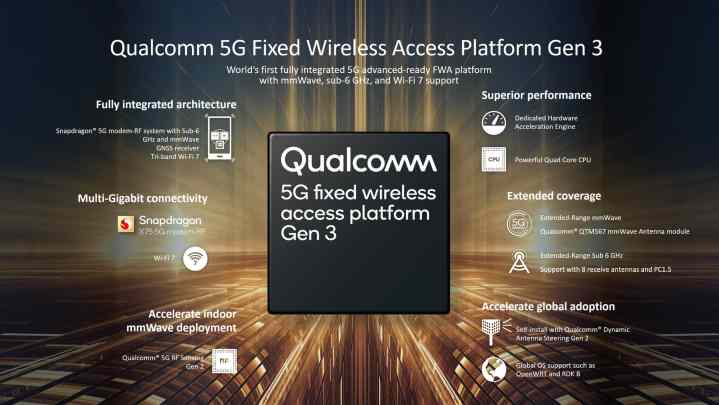Qualcomm has just announced the Snapdragon X75, the company’s sixth-generation 5G modem that promises to push smartphones and other connected devices into the next phase of 5G technology.
The Snapdragon X75 is the successor to last year’s X70, which is the modem found in the Snapdragon 8 Gen 2 that powers this year’s most powerful 5G smartphones — including Samsung’s recently unveiled Galaxy S23 Ultra and the OnePlus 11. However, it’s more than just an evolution of that earlier modem system, as Qualcomm has packed in support for next-generation 5G Advanced technology along with an entirely new architecture and powerful AI features that will allow mobile devices to access better coverage and achieve even faster speeds.
5G grows up big-time

Although existing 5G technology has already gained a lot of forward momentum over the past few years, it’s far from a static platform. In fact, 5G has been evolving, and we’re already in the third phase of 5G, which is actually the 17th major version of the 3rd Generation Partnership Project (3GPP) cellular communication standards that began over 30 years ago with basic GSM.
The first four 5G releases occurred from 2017 to 2021 and built the foundational structure of 5G technology. These standards evolved 5G into the mature and stable platform that we have today. Now that this groundwork has been laid, it’s time for 5G to move from foundational to transformational with the introduction of 5G Advanced, also known as 3GPP Release 18. This is the fourth phase of 5G, and it’s a big one — which is exactly where Qualcomm’s Snapdragon X75 comes in.

While the new modem chip will offer the usual improvements that come with newer and faster silicon, there’s much more to it than just raw performance. Qualcomm is taking advantage of a wide array of new capabilities that make up the new 5G Advanced standard to drive even faster multi-gigabit speeds through improved carrier aggregation and better mmWave connectivity that will minimize frequency hopping to provide more stable and reliable connections while also minimizing interference. This means faster speeds as devices can remain on the same channels more consistently. The X75 will also be able to transmit two simultaneous signals instead of just one, potentially driving even faster uplink speeds.
The Snapdragon X75 is also the first modem system with a dedicated hardware tensor accelerator. Qualcomm’s 5G AI Processor Gen 2 promises 2.5 times better AI performance compared to the first-generation chip used in last year’s X70, which means an even more intelligent selection of the optimal frequencies for the best possible connection.

Combined with Qualcomm’s new software suite, this should also provide better-sustained performance for users moving around in more complex environments where maintaining 5G connectivity has traditionally been a challenge, such as in elevators, subway trains, airports, and parking garages. There’s also support for enabling 5G and 4G Dual Data on two SIM cards simultaneously, along with even more power efficiency improvements to allow for extended battery life and longer run times.
Naturally, there’s support for Snapdragon Satellite. While that’s technically also supported in the X70 used in the Snapdragon 8 Gen 2, Qualcomm has already told us not to expect to see it before the second half of this year, which is also around the time the Snapdragon X75 is supposed to begin appearing in next-generation phones.
It’s not just for smartphones

The Snapdragon X75 goes well beyond being merely a smartphone chip. It’s the next big push to bring 5G connectivity into the mainstream. It’s the foundation of Qualcomm’s Fixed Wireless Access Platform Gen 3, which uses mmWave, Sub-6GHz, tri-band Wi-Fi 7, and 10Gb Ethernet to deliver multi-gigabit broadband speeds to all your home devices over 5G — with latency that’s comparable to traditional fiber connections.
It’s also expected to power a new generation of private 5G networks for university campuses, resorts, retail malls, industrial plants, connected cars, and much more. Working in tandem with the Snapdragon X35 announced earlier this month, Qualcomm’s newest chips are taking the next step into a fully connected world.
A big step on the road to 6G
Like the LTE Advanced of the last generation, 5G Advanced is also the first major step on the road to 6G technology. The Federal Communications Commission (FCC) and network operators are already making plans for this next big leap, and while 5G Advanced is not at all the same as 6G, it does pave the way by giving operators a head start on adopting the more advanced technologies that will make up the 6G standard.
In fact, 3GPP, the group that manages all of the cellular standards that grew out of GSM, is expected to draft the 6G requirements as part of the very next major standards update, 3GPP Release 19, which is expected to arrive sometime next year alongside the next phase of 5G Advanced. A 6G study will begin with Release 20 around 2025/2026, after which the foundational 6G standard is expected to be drafted and ready to begin rolling out by 2028. These standards will be built upon the 5G Advanced technology we’re seeing today in Qualcomm’s X75, and there’s little doubt that Qualcomm is going to remain ahead of the curve on the march toward even more immersive wireless communication technologies.
Editors' Recommendations
- Have an Android phone? You can get unlimited 5G service for free
- How fast is 5G? What you need to know about 5G speeds
- The 5G speed race is over and T-Mobile has won
- Netgear’s new M6 Pro router lets you use fast 5G anywhere you go
- Live in a rural area? Verizon 5G is about to get better for you




